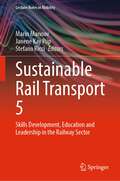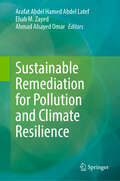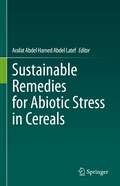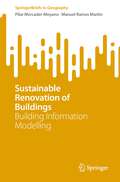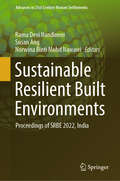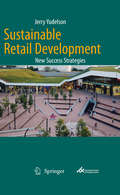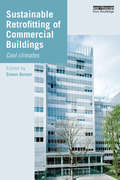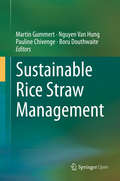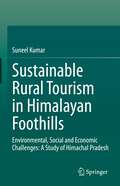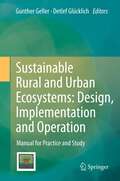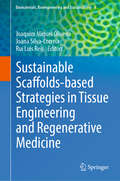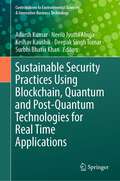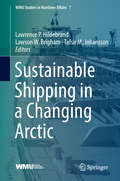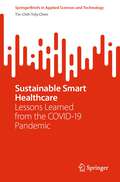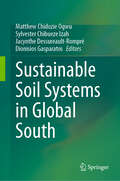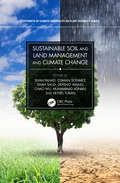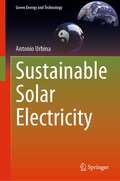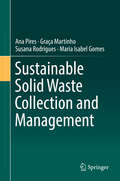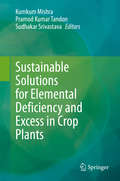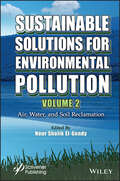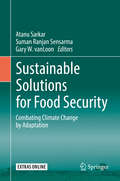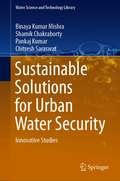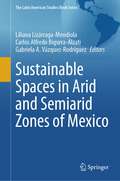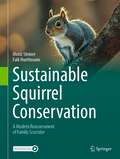- Table View
- List View
Sustainable Rail Transport 5: Skills Development, Education and Leadership in the Railway Sector (Lecture Notes in Mobility)
by Marin Marinov Stefano Ricci Janene Kay PiipThis book offers a timely collection of chapters on innovative research and education-focused developments in the vast field of rail transport, including rail operations, management, economics, and sustainable infrastructure. Adding on the tradition of the previous four volumes, here a special emphasis is given on the current needs for rail skills development, innovating rail higher education provision, and solutions aimed at bridging the gap between railway education and industry expectations. Strategies for making the rail sector more attractive to early careers and younger generations, and methods to identify and retain talents in the railway sector are also described. Gathering peer-reviewed contributions prepared by the RailUniNet and AstonRail strategic partnership members, this book offers a timely view on current developments on rail-focused teaching and learning methods and approaches with extensive information for both academics and professionals specialising in railway research, technologies, training and education.
Sustainable Remediation for Pollution and Climate Resilience
by Arafat Abdel Hamed Abdel Latef Ehab M. Zayed Ahmad Alsayed OmarThis book offers a comprehensive exploration of strategies to combat pressing environmental challenges, focusing on pollution remediation and climate change mitigation. It presents innovative recycling models and advanced tertiary water treatment methods as viable solutions to these global issues. As humanity faces the consequences of pollution, from plastic waste to industrial contamination, this book highlights the need for sustainable practices that ensure environmental and biological continuity. It addresses the critical question of how to remediate plastic pollution, a major environmental crisis affecting marine life, terrestrial ecosystems, and human health. The chapters cover a wide range of topics, including the comparison of bioremediation and nanomaterials, phytoremediation of domestic wastewater, and the integration of mine rehabilitation practices in the context of climate change. Readers will discover the ecological importance of bacteria and fungi in bioremediation, the role of microbes in environmental restoration, and the potential of phycoremediation algae in mitigating climate change. The book also examines the impact of viral and fungal remediation in creating a healthy environment and the role of biofertilizers in soil remediation. This volume is essential for researchers, environmental scientists, and policymakers seeking to understand and implement effective pollution remediation strategies. It offers valuable insights into the intersection of technology and ecology, making it a must-read for anyone committed to preserving our planet for future generations.
Sustainable Remedies for Abiotic Stress in Cereals
by Arafat Abdel Hamed Abdel LatefThis book is an elaborate account of the effects of abiotic stressors on cereals crops. It not only discusses the impacts of abiotic stress on the crops but also the physiological, biochemical, and molecular strategies applied in plant of cereal crops to alleviate the detrimental effects of abiotic stressors. The book also elaborates on various molecular response to the abiotic stress. It is a knowledgebase providing readers latest updates on development of high-performance diagnostics, stress induced responses, genomics, phenomics and metabolomics involved in abiotic stress tolerance of cereal food crops. The book is useful for plant scientists and research scholars. Post graduate students of agriculture sciences, plant physiology, botany and biochemistry also benefit from this compilation.
Sustainable Renovation of Buildings: Building Information Modelling (SpringerBriefs in Geography)
by Pilar Mercader-Moyano Manuel Ramos MartínThe book provides a complete vision about Spanish sustainable renovation of buildings situation at this moment, analysing legal and technological context and opportunities that economic stimulus —by means of direct aids— and the use of BIM methodologies offers a standardization of high scale interventions.Nowadays, BIM models let us integrate multiple quantitative parameters that can agile the information to interchange between stakeholders. Using this potential to standardize protocols of interventions and share knowledge is necessary to face a high scale intervention that our cities need.Climatic Emergency and socioeconomic crisis caused by recent events —COVID-19 and hydrocarbons crisis— are the two principal struggles we face as society. European Politics, embodied by National Energy and Climate Plans (NECPs) developed by each region give the way to the green transition of different productive sectors.Our building stock is responsible for approximately 36% of the CO2 emissions in the European Union. For this reason, these policies focus a large part of their efforts on economically incentivizing a new development model for the building sector that is committed to the large-scale renovation of the existing real estate stock and that, through the reduction of energy demand and of emissions, manage to reduce the environmental impact of these. Next Generation EU is the new recovery instrument that aims to mobilize investments towards strategic sectors for the reorientation of the production model that, among other measures, contributes to decarbonization through the promotion of energy efficiency and the deployment of renewable energies.
Sustainable Resilient Built Environments: Proceedings of SRBE 2022, India (Advances in 21st Century Human Settlements)
by Susan Ang Rama Devi Nandineni Norwina Binti Mohd NawawiThe proceedings of Sustainable Resilient Built Environments are based on the SRBE 2022 conference held in December 2022. It focuses on the advances under the overarching theme of ‘Sustainability’. The concept of ‘Sustainability’ has been conventionally defined as meeting the needs of the present without compromising the ability of future generations to meet their own needs. In scientific literature, sustainable development has been analysed using different qualitative approaches, such as economic, social, ecological, cultural, institutional, ethical, and political. In this edited volume, the concepts of both ‘sustainability’, and ‘resilience’ are considered to open up useful pathways towards achieving sustainable buildings and infrastructure. Though the concepts of sustainability and resilience are considered to help improve the built environment, the interrelations and interdependence between these two concepts are not clearly evident. This has led to the questions such as: Is thesustainable built environment always resilient? Is the resilient built environment always sustainable? What more is needed for sustainability? In exploring these pertinent questions, the proposed edited volume is expected to unveil and disseminate new insights on the themes related to sustainable and resilient built environment.The themes of the proceedings lay a platform for researchers and professionals to integrate the aspects including smart, innovation, technologies, green, energy efficiency, carbon reduction, sustainability and resilience with regard to buildings and other built infrastructure. Specific objectives included as per the five themes are as follows:Environment Design and SustainabilitySustainable & Smart BuildingsCommunity Resilience & Social SustainabilityHeritage and SustainabilityPandemic issues and sustainable development
Sustainable Retail Development: New Success Strategies
by Jerry YudelsonSustainable Retail Development, addresses the emerging issue of green retail buildings and retail development that will grow significantly in importance over the next half-decade, a trend seen throughout the developed world. This volume is a practical and comprehensive guide to greening retail real estate, including green building and marketing strategies, corporate sustainability programs and features a 10-point "action program" for greening any retail real estate portfolio. Sustainable Retail Development, should be essential reading for professionals in design, construction and operations of shopping centers and retail stores. Well illustrated, this volume features over 30 green retail developments from North America, Europe, South America, Asia and Australia, as well as interviews with 25 leading industry experts.
Sustainable Retrofitting of Commercial Buildings: Cool Climates
by Simon BurtonWhilst sustainability is already an important driver in the new building sector, this book explores how those involved in refurbishment of commercial building are moving this agenda forward. It includes chapters by developers, surveyors, cost consultants, architects, building physicists and other players, on the role they each can play in enabling refurbishment to be commercially, environmentally and socially sustainable. Case studies from northern climates show real examples of different building types, ages and uses and will demonstrate what action has been taken to create more sustainable buildings. The chapters raise and discuss all the relevant issues that need to be considered in retrofitting decision making. Changing standards, planning, process management, financing, technical issues, site organisation, commissioning and subsequent building management are all considered. The book demonstrates that buildings can be made comfortable to occupy, easy to manage and low in energy demand and environmental impact.
Sustainable Retrofitting of Commercial Buildings: Warm Climates
by Ken Yeang Richard Hyde Nathan Groenhout Francis BarramDespite recent improvements in energy efficiency being made in new build, it is important that the existing commercial building sector also take action to meet emission reduction targets. The objectives and challenges of such action will reduce the risk of the sector becoming obsolete due to high energy use and poor environmental performance. This book presents a theory-based, practice-support methodology to deal with sustainable retrofitting opportunities for existing commercial buildings in warm climates using bioclimatic design as the basis. The book has four main parts, focusing on eco-design and renovation, bioclimatic retrofitting, technological and behavioural change and case studies of retrofitting exemplars. In the first part, the context of climate change effects on design and renovation at the city scale is discussed. The second part looks at bioclimatic retrofitting as a 'design guide' for existing buildings, highlighting the significance of architectural design and engineering systems for energy performance. The technological and behavioural contexts of the existing building sector – policies, modelling, monitoring and trend analysis in respect to energy and environmental performance – are covered in part three. The final part gives some case studies showing the effectiveness of strategies suggested for effective environmental performance. This book is a must-have guide for all involved in the design and engineering of retrofitting projects in warm climates.
Sustainable Rice Straw Management
by Martin Gummert Nguyen Van Hung Pauline Chivenge Boru DouthwaiteThis open access book on straw management aims to provide a wide array of options for rice straw management that are potentially more sustainable, environmental, and profitable compared to current practice. The book is authored by expert researchers, engineers and innovators working on a range of straw management options with case studies from Vietnam, the Philippines and Cambodia. The book is written for engineers and researchers in order to provide them information on current good practice and the gaps and constraints that require further research and innovation. The book is also aimed at extension workers and farmers to help them decide on the best alternative straw management options in their area by presenting both the technological options as well as the value chains and business models required to make them work. The book will also be useful for policy makers, required by public opinion to reduce greenhouse gas emissions and air pollution, looking for research-based evidence to guide the policies they develop and implement.
Sustainable Rural Tourism in Himalayan Foothills: Environmental, Social and Economic Challenges: A Study of Himachal Pradesh
by Suneel KumarThis book discusses the development of the rural tourism industry in the Himalayan region, specifically in the region of Himachal Pradesh (HP), from the perspective of different stakeholders in the tourism industry. It examines the current status and trends of rural tourism in HP, discusses the challenges faced in response to the vulnerability of the Himalayas to global climate change, and evaluates the consequences of rural tourism on the socio-economic structure in HP to sustainably formulate a framework for promoting financial and social inclusion. This framework covers flexible strategies for planning rural tourism development, assesses the role of technology in the tourism industry in achieving the objective of social and financial inclusion, and identifies the factors influencing a tourist’s decision to undertake rural tourism and develop a hierarchical relationship among those factors. The book will be of interest to students and researchers of sustainable rural tourism and tourism economics, as well as stakeholders from various sectors aiming to sustainably improve the ecological and economic fragility of the Himalayas due to climate change.
Sustainable Rural and Urban Ecosystems: Design, Implementation and Operation
by Detlef Glücklich Gunther GellerThese days human beings have a profound influence on aspects of the planetary ecosystem, e.g. on climate change and biodiversity, to name only two. This manual is intended to help practitioners, who are dealing with human-based rural and urban settlement-ecosystems, in the key steps towards their realization (design, implementation, and operation) and helpful for all, who are concerned about ensuring their practical sustainability. The ecosystem-approach is holistic and integrative, encompassing various disciplines like architecture, landscape architecture, environmental engineering, social sciences, life sciences, ecology, and management. It also considers issues such as energy-savings, ecological cycles, reuse, natural resources, socio-cultural background, real participation, and holistic quality management. Thus it not only explains the general concept, the steps of realization and the respective involved stakeholders, but also gives hints and tools for practitioners. The information, recommendations and tools are directed to the following target groups, among others: * Local planning authorities (giving hints for the procedure and the involved stakeholders) * Designers (holistic approach, procedures, tools) * Regulatory bodies, licensing and financing authorities (requirements for approach and procedures) * Construction and implementing firms and institutions (recommendations, tools) * Operating bodies (hints for operation, tools) The experiences are based on a joint German-Ghanaian program at Valley View University, the biggest private university in Ghana, intended to help realize the vision of a truly holistic ecological university. It was financed originally by the German Ministry of Education and Research and recently by the German Ministry for the Environment in the frame of the Climate Change Initiative of the Federal Government of Germany.
Sustainable Scaffolds-based Strategies in Tissue Engineering and Regenerative Medicine (Biomaterials, Bioengineering and Sustainability #8)
by Joaquim Miguel Oliveira Rui Luís Reis Joana Silva-CorreiaThis book aims to provide a concise overview on the relevant research dealing with the design and fabrication methods of novel scaffolds, considering not only the technological challenges, but also the increasingly important sustainability issues. In this context, the vast options of sustainable biomaterials and eco-friendly/green methods for biomaterials synthesis and scaffold&’s processing techniques are discussed. Importantly, the recent developments in the field of scaffolds-based strategies for tissue engineering and regenerative medicine applications are also provided. In brief, the book is divided into three main sections comprising 15 chapters, as follows: I - Sustainable scaffold techniques and designs in tissue engineering; II - Natural materials and eco-wastes used as sacrificial templates; and III - Biomedical applications. It will also provide a concluding section about the Editor&’s opinion on the current achievements and future directions of the field. This book includes the contribution of leading and multidisciplinary experts, which will provide a in depth discussion on sustainable scaffolds for biomedical applications, thus serving as an up-to-date reference for a new generation of multidisciplinary students and researchers which aim to consider the sustainability dimension in their research activities.
Sustainable Security Practices Using Blockchain, Quantum and Post-Quantum Technologies for Real Time Applications (Contributions to Environmental Sciences & Innovative Business Technology)
by Adarsh Kumar Keshav Kaushik Deepak Singh Tomar Neelu Jyothi Ahuja Surbhi Bhatia KhanThis book focuses on the sustainable security practices in the domain of blockchain, quantum, and post-quantum technologies dealing with the real-time applications. The topics discussed in this book include banking applications, protection of digital assets in healthcare, military defense applications, supply chain management, secure messaging, and keyless secure infrastructures.Blockchains and quantum technologies are the emerging technological developments both in academic and industrial domains. The problems related to quantum threat and execution of post-quantum signatures in a blockchain platform have become hot topics in today's scientific community because they have remarkably progressed in recent years and have found a variety of applications.This book is a valuable resource for academicians, researchers, students, and technicians in the field of blockchain and quantum computing.
Sustainable Shipping in a Changing Arctic (WMU Studies in Maritime Affairs #7)
by Lawrence P. Hildebrand Lawson W. Brigham Tafsir M. JohanssonThis volume brings together multiple perspectives on both the changing Arctic environment and the challenges and opportunities it presents for the shipping sector. It argues for the adoption of a forward-looking agenda that respects the fragile and changing Arctic frontier. With the accelerated interest in and potential for new maritime trade routes, commercial transportation and natural resource development, the pressures on the changing Arctic marine environment will only increase. The International Maritime Organization Polar Code is an important step toward Arctic stewardship. This new volume serves as an important guide to this rapidly developing agenda. Addressing a range of aspects, it offers a valuable resource for academics, practitioners, environmentalists and affected authorities in the shipping industry alike.
Sustainable Smart Healthcare: Lessons Learned from the COVID-19 Pandemic (SpringerBriefs in Applied Sciences and Technology)
by Tin-Chih Toly ChenThis book shows how smart technology applications to mobile healthcare will be different in the post-pandemic era. Prior to the Covid-19 pandemic, smart technologies had been widely applied to mobile health care. It will be the same in the post pandemic. However, the widely used smart technologies before and after the Covid-19 pandemic may be different. First, users’ motivations for applying smart technologies have changed. In addition, some innovative ways of applying smart technologies within the Covid-19 pandemic have emerged. Further, users’ acceptance of smart technology applications has increased. Furthermore, new smart technologies are still being proposed. This book discusses these topics.
Sustainable Soil Systems in Global South
by Sylvester Chibueze Izah Matthew Chidozie Ogwu Jacynthe Dessureault-Rompré Dionisios GasparatosWith a focus on soil systems (status, properties, functionality, diagnosis, roles, assessment, conservation, knowledge, practices, productivity, management, policies, climate, biodiversity, etc.), this book addresses gaps pertinent to promoting sustainable human-environment in the Global South and beyond. The soil system is a complex and dynamic part of the lithosphere with flows, inputs, storage, and output that connects it with other Earth systems. It is a living unit whose physical, chemical, and biological characteristics are dependent on the process of its formation, parent material, age, organic and inorganic constituent, and climate and relief. From a systems standpoint, balancing the relationship between utilization and management will help maintain soil health and the provision of ecosystem services. A healthy soil system is capable of functioning as a living unit to support other life and life processes and contribute to sustainable development in the Global South. This book is of interest and useful to soil, biological and agricultural scientists, trainees and trainers, agricultural institutes, soil and food systems specialists, biodiversity and environmental managers, practitioners, activists, and students (especially undergraduates and postgraduates) in the Global South and beyond.
Sustainable Soil and Land Management and Climate Change (Footprints of Climate Variability on Plant Diversity)
by Shah Fahad Muhammad Adnan Shah Saud Depeng Wang Chao Wu Veysel Turan Osman SönmezThe third volume of Sustainable Soil and Land Management and Climate Change presents a complete overview of plant soil interactions in a climate affected by greenhouse gas emissions and organic carbon. It presents approaches and managements strategies for the stabilization of soil organic matter.The latest in the respected Footprints of Climate Variability on Plant Diversity series, this book enhances the reader’s knowledge of the preservation of organic matter through microbial approaches as well as through soil and plant interactions. Written by teams of specialist scientists, it presents research outcomes, practical applications and future challenges for this important field.Features: Presents microbial tactics for the alleviation of potentially toxic elements in agricultural soils and for reclaiming saline soil. Provides an overview of scientific investigations into greenhouse gas emissions. Outlines priming techniques developed in response to a changing climate. This book is written for students of agronomy, soil science and the environmental sciences as well as researchers interested in management technologies to improve soil fertility.
Sustainable Solar Electricity (Green Energy and Technology)
by Antonio UrbinaThis book provides a detailed life cycle assessment of photovoltaic technologies in order to analyse the environmental and socioeconomic impacts that a large deployment of solar photovoltaic systems will produce in the near future. Including both commercial and emerging technologies, the book presents the energy and materials requirements to manufacture solar electricity power systems at the order of the TeraWatt scale deployment as is envisaged by the International Renewable Energy Agency (IRENA) for the near future. It discusses current manufacturing practices and how these may be adapted in the future including: reuse and recycling of components and materials; raw material supply chains to the manufacturing factories; and end-of-life procedures including recycling and landfilling of modules. The environmental and socioeconomic impacts of solar energy are analysed in detail, providing recommendations for standardization and regulations in order to make photovoltaic technologies, both current and emerging, a really sustainable alternative for the supply of “greener” electricity.
Sustainable Solid Waste Collection and Management
by Ana Pires Graça Martinho Susana Rodrigues Maria Isabel GomesThis volume focuses on the collection of waste and waste streams as an integral aspect of sustainable waste management. The authors take economic models and behavioral studies into account to go beyond just descriptions of waste collections technologies and collection route design. Models and tools for sustainable waste collection are described in detail, and the authors provide a comprehensive, integrated methodology to design waste collection systems that reduce environmental impacts, are economically viable, and achieve buy-in and participation from target populations. Part I of the book provides fundamentals and context on waste hierarchy, including waste prevention, reduction and reuse, waste collection itself, and steps such as preparation for recycling, recycling, treatment, and landfilling. Background in environmental, social, and economic concerns surrounding waste collection is also provided here. Part II addresses tools for design, operation, and maintenance of waste collection systems. Part III focuses on how the tools presented in Part II can be used to support sustainability assessments and decisions that consider the entire life cycle of waste and the role of waste collection programs in waste prevention, reduction, reuse, recycling, treatment, and disposal. Part IV addresses the challenges of developing sustainable waste management systems and addresses the role of waste collection in sustainable waste management in the future.
Sustainable Solutions for Elemental Deficiency and Excess in Crop Plants
by Sudhakar Srivastava Kumkum Mishra Pramod Kumar TandonThis book covers all aspects of deficiency of essential elements and excess of toxic ones in crop plants. The metal deficiency and toxicity are the two sides of same problem that are threatening to sustainable agricultural growth. The book presents prospective strategies for the management of elemental nutrition of crop plants. Chapters are arranged in a manner so as to develop a lucid picture of the topic beginning from basics to advanced research. The content is supplemented with flow charts and figures to make it convenient for readers to holistically grasp the concepts. It will be a value addition for students, research scholars and professionals in understanding the basics as well latest developments in the area of metal deficiency and excess in crop plants.
Sustainable Solutions for Environmental Pollution, Volume 2: Air, Water, and Soil Reclamation
by Nour Shafik El-GendySUSTAINABLE SOLUTIONS FOR ENVIRONMENTAL POLLUTIONS This second volume in a broad, comprehensive two-volume set, “Sustainable Solutions for Environmental Pollution”, concentrates on air, water, and soil reclamation, some of the biggest challenges facing environmental engineers and scientists today. This second, new volume in the two-volume set, Sustainable Solutions for Environmental Pollution, picks up where volume one left off, covering the remediation of air, water, and soil environments. Outlining new methods and technologies for all three environmental scenarios, the authors and editor go above and beyond, introducing naturally-based techniques in addition to changes and advances in more standard methods. Written by some of the most well-known and respected experts in the field, with a prolific and expert editor, this volume takes a multidisciplinary approach, across many scientific and engineering fields, intending the two-volume set as a “one-stop shop” for all of the advances and emerging techniques and processes in this area. This groundbreaking new volume in this forward-thinking set is the most comprehensive coverage of all of these issues, laying out the latest advances and addressing the most serious current concerns in environmental pollution. Whether for the veteran engineer or the student, this is a must-have for any library. This volume: Offers new concepts and techniques for air, water, and soil environment remediation, including naturally-based solutions Provides a comprehensive coverage of removing heavy chemicals from the environment Offers new, emerging techniques for pollution prevention Is filled with workable examples and designs that are helpful for practical applications Is useful as a textbook for researchers, students, and faculty for understanding new ideas in this rapidly emerging field AUDIENCE: Petroleum, chemical, process, and environmental engineers, other scientists and engineers working in the area of environmental pollution, and students at the university and graduate level studying these areas.
Sustainable Solutions for Food Security: Combating Climate Change by Adaptation
by Atanu Sarkar Suman Ranjan Sensarma Gary W. VanLoonThis volume is the first centralized source of technological and policy solutions for sustainable agriculture and food systems resilience in the face of climate change. The editors have compiled a comprehensive collection of the latest tested, replicable green technologies and approaches for food security, including smart crops and new agricultural paradigms, sustainable natural resources management, and strategies for risk assessment and governance. Studies from resource-constrained countries with vulnerable populations are emphasized, with contributions on multisector partnership from development professionals. Debates concerning access to climate-smart technologies, intellectual property rights, and international negotiations on technology transfer are also included. The editors are, respectively, a public health physician, a development professional and an environmental scientist. They bring their varied perspectives together to curate a holistic volume that will be useful for policy makers, scientists, community-based organizations, international organizations and researchers across the world.
Sustainable Solutions for Urban Water Security: Innovative Studies (Water Science and Technology Library #93)
by Shamik Chakraborty Pankaj Kumar Binaya Kumar Mishra Chitresh SaraswatThis book presents solutions to address water security in rapidly urbanizing cities, and explores the new paradigms of water security in changing contexts. Highlighting the latest developments in water research, changes in water policy, and current discourses on water security, the book also provides information and tools for local stakeholders, water managers, and policymakers to build the capacity for sustainable water governance. The book discusses a wide range of sustainable solutions and their implementation to ensure that the balance between water supply and demand remains sustainable in the long term, with a focus on local solutions to build capacity and developing policy awareness for a wide range of stakeholders. As the concept of urban water security in changing contexts is open to multiple interpretations, the authors set out various approaches. Providing an overview of the changing perspectives of urban water security in different contexts, the book is based on findings of the Asia-Pacific Network water security project at the United Nations University, Tokyo, as well as the authors' current research-based at Pokhara University, Nepal, Hosei University, Tokyo, Institute for the Global Environmental Strategies, Japan and the Australian National University, Australia. The book also includes the views of international authorities (such as water experts) on the subject. The solutions are complemented by analysis of case studies of various localized sustainable solutions at different scales. The book is a valuable resource for water professionals and policymakers around the globe, academics, teachers working in water-related areas, NGOs, think thanks, water research institutes, donor organizations, and international and local water utility services.
Sustainable Spaces in Arid and Semiarid Zones of Mexico (The Latin American Studies Book Series)
by Liliana Lizárraga-Mendiola Carlos Alfredo Bigurra-Alzati Gabriela A. Vázquez-RodríguezThis book portrays interesting aspects of communities where livability, comfort, materials, and traditional construction procedures are part of the cultural context. The book is focused on the importance of incorporating environmental criteria and sustainable infrastructure to contribute to the Sustainable Development Goals and to improve the population's quality of life in arid and semi-arid zones of the Global South. This book constitutes an introduction to the sustainable construction of livable spaces for undergraduate and postgraduate students, although professionals of the construction industry and urban policy makers will also find this work valuable.
Sustainable Squirrel Conservation: A Modern Reassessment of Family Sciuridae
by Falk Huettmann Moriz SteinerThis book attempts to move the family of squirrels (Sciuridae) out of the shadow of large charismatic mammals and to highlight management failures with the goal of moving towards an improved conservation approach. Particular attention is paid to the influence of taxonomic science on squirrel conservation. In addition, the authors show how human-driven climate change, global change and modern politics are shaping global squirrel populations as well as their surrounding environments and ecosystems.Squirrels are widespread around the globe, naturally occurring on every continent except Antarctica and Oceania, and they are certainly among the animals most commonly encountered in everyday life. Despite this, the authors of this volume identify worrying gaps in squirrel conservation. Squirrels are often hunted, trapped, poached, and stressed, and management strategies and legislation are often devised in the absence of proper knowledge of issues such as population sizes, taxonomies, and trends. Together, this can result in severe population declines and even species extinction. By assessing their taxonomic situation, ecology, the evolution and divergence of Sciuridae around the globe, and squirrels’ well-being across habitats, the authors set a baseline from which to launch future investigations into the conservation of squirrels and other species. Additionally, the authors highlight the influences of climate change, unsustainable growth, and various man-made threats to the future of this family.
